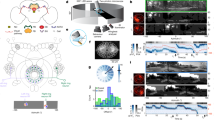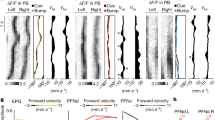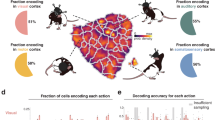Abstract
The fly Drosophila melanogaster can discriminate and remember visual landmarks. It analyses selected parts of its visual environment according to a small number of pattern parameters such as size, colour or contour orientation, and stores particular parameter values. Like humans, flies recognize patterns independently of the retinal position during acquisition of the pattern (translation invariance). Here we show that the central-most part of the fly brain, the fan-shaped body, contains parts of a network mediating visual pattern recognition. We have identified short-term memory traces of two pattern parameters—elevation in the panorama and contour orientation. These can be localized to two groups of neurons extending branches as parallel, horizontal strata in the fan-shaped body. The central location of this memory store is well suited to mediate translational invariance.
This is a preview of subscription content, access via your institution
Access options
Subscribe to this journal
Receive 51 print issues and online access
$199.00 per year
only $3.90 per issue
Buy this article
- Purchase on Springer Link
- Instant access to full article PDF
Prices may be subject to local taxes which are calculated during checkout





Similar content being viewed by others
References
Heisenberg, M. & Wolf, R. On the fine structure of yaw torque in visual flight orientation of Drosophila melanogaster. J. Comp. Physiol. [A] 130, 113–130 (1979)
Xia, S., Liu, L., Feng, C. & Guo, A. Memory consolidation in Drosophila operant visual learning. Learn. Mem. 4, 205–218 (1997)
Dill, M. & Heisenberg, M. Visual pattern memory without shape recognition. Phil. Trans. R. Soc. Lond. B 349, 143–152 (1995)
Dill, M., Wolf, R. & Heisenberg, M. Visual pattern recognition in Drosophila involves retinotopic matching. Nature 365, 751–753 (1993)
Dill, M., Wolf, R. & Heisenberg, M. Behavioral analysis of Drosophila landmark learning in the flight simulator. Learn. Mem. 2, 152–160 (1995)
Ernst, R. & Heisenberg, M. The memory template in Drosophila pattern vision at the flight simulator. Vision Res. 39, 3920–3933 (1999)
Tang, S., Wolf, R., Xu, S. & Heisenberg, M. Visual pattern recognition in Drosophila is invariant for retinal position. Science 305, 1020–1022 (2004)
Gerber, B., Tanimoto, H. & Heisenberg, M. An engram found? Evaluating the evidence from fruit flies. Curr. Opin. Neurobiol. 14, 737–744 (2004)
Brand, A. H. & Perrimon, N. Targeted gene expression as a means of altering cell fates and generating dominant phenotypes. Development 118, 401–415 (1993)
McGuire, S. E., Le, P. T., Osborn, A. J., Matsumoto, K. & Davis, R. L. Spatiotemporal rescue of memory dysfunction in Drosophila. Science 302, 1765–1768 (2003)
Dudai, Y., Corfas, G. & Hazvi, S. What is the possible contribution of Ca2+-stimulated adenylate cyclase to acquisition, consolidation and retention of an associative olfactory memory in Drosophila. J. Comp. Physiol. [A] 162, 101–109 (1988)
Levin, L. R. et al. The Drosophila learning and memory gene rutabaga encodes a Ca2+/Calmodulin-responsive adenylyl cyclase. Cell 68, 479–489 (1992)
Abrams, T. W., Yovell, Y., Onyike, C. U., Cohen, J. E. & Jarrard, H. E. Analysis of sequence-dependent interactions between transient calcium and transmitter stimuli in activating adenylyl cyclase in Aplysia: possible contribution to CS–US sequence requirement during conditioning. Learn. Mem. 4, 496–509 (1998)
Renger, J. J., Ueda, A., Atwood, H. L., Govind, C. K. & Wu, C. F. Role of cAMP cascade in synaptic stability and plasticity: ultrastructural and physiological analyses of individual synaptic boutons in Drosophila memory mutants. J. Neurosci. 20, 3980–3992 (2000)
Zars, T., Fischer, M., Schulz, R. & Heisenberg, M. Localization of a short-term memory in Drosophila. Science 288, 672–675 (2000)
McGuire, S. E., Le, P. T. & Davis, R. L. The role of Drosophila mushroom body signalling in olfactory memory. Science 293, 1330–1333 (2001)
Connolly, J. B. et al. Associative learning disrupted by impaired Gs signalling in Drosophila mushroom bodies. Science 274, 2104–2107 (1996)
Dubnau, J., Grady, L., Kitamoto, T. & Tully, T. Disruption of neurotransmission in Drosophila mushroom body blocks retrieval but not acquisition of memory. Nature 411, 476–480 (2001)
Schwaerzel, M., Heisenberg, M. & Zars, T. Extinction antagonizes olfactory memory at the subcellular level. Neuron 35, 951–960 (2002)
Zars, T., Wolf, R., Davis, R. & Heisenberg, M. Tissue-specific expression of a type I adenylyl cyclase rescues the rutabaga mutant memory defect: in search of the engram. Learn. Mem. 7, 18–31 (2000)
Heisenberg, M. Central Brain Function in Insects: Genetic Studies on the Mushroom Bodies and Central Complex in Drosophila (eds Schildberger, K. & Elsner, N.) (Gustav Fischer, Stuttgart/Jena/New York, 1994)
Strauss, R. The central complex and the genetic dissection of locomotor behaviour. Curr. Opin. Neurobiol. 12, 633–638 (2002)
Homberg, U. In search of the sky compass in the insect brain. Naturwissenschaften 91, 199–208 (2004)
Strauss, R. Die übergeordnete Steuerung des Laufverhaltens durch das Insektengehirn, studiert mit Methoden der Drosophila-Neurogenetik. Habilitation thesis, Bayerische Julius-Maximilians-Universität, Wuerzburg (2002)
Weidtmann, N. Visuelle Flugsteuerung und Verhaltensplastizität bei Zentralkomplexmutanten von Drosophila melanogaster. Diploma thesis, Bayerische Julius-Maximilians-Universität, Wuerzburg (1993)
Strauss, R. & Heisenberg, M. A higher control center of locomotor behaviour in the Drosophila brain. J. Neurosci. 13, 1852–1861 (1993)
Keller, A., Sweeney, S. T., Zars, T., O'Kane, C. J. & Heisenberg, M. Targeted expression of tetanus neurotoxin interferes with behavioural responses to sensory input in Drosophila. J. Neurobiol. 50, 221–233 (2002)
Broadie, K. et al. Syntaxin and synaptobrevin function downstream of vesicle docking in Drosophila. Neuron 15, 663–673 (1995)
Eyding, D. Lernen und Kurzzeitgedächtnis beim operanten Konditionieren auf visuelle Muster bei strukturellen und biochemischen Mutanten von Drosophila melanogaster. Diploma thesis, Bayerische Julius-Maximilians-Universität, Wuerzburg (1993)
Brembs, B. & Heisenberg, M. The operant and the classical in conditioned orientation of Drosophila melanogaster at the flight simulator. Learn. Mem. 7, 104–115 (2000)
Prokop, A. & Technau, G. M. Normal function of the mushroom body defect gene of Drosophila is required for the regulation of the number and proliferation of neuroblasts. Dev. Biol. 161, 321–337 (1994)
Wolf, R. et al. Drosophila mushroom bodies are dispensable for visual, tactile, and motor learning. Learn. Mem. 5, 166–178 (1998)
Fischbach, K. F. & Dittrich, A. P. M. The optic lobe of Drosophila melanogaster. A Golgi analysis of wild-type structure. Cell Tissue Res. 258, 441–475 (1989)
Hanesch, U., Fischbach, K. F. & Heisenberg, M. Neuronal architecture of the central complex in Drosophila melanogaster. Cell Tissue Res. 257, 343–366 (1989)
Vitzthum, H., Muller, M. & Homberg, U. Neurons of the central complex of the locust Schistocerca gregaria are sensitive to polarized light. J. Neurosci. 22, 1114–1125 (2002)
Wolf, R. & Heisenberg, M. Basic organization of operant behaviour as revealed in Drosophila flight orientation. J. Comp. Physiol. [A] 169, 699–705 (1991)
Heisenberg, M. & Wolf, R. Reafferent control of optomotor yaw torque in Drosophila melanogaster. J. Comp. Physiol. [A] 163, 373–388 (1988)
Acknowledgements
We thank B. Gerber and H. Tanimoto for valuable comments on the manuscript, C. Grübel, Haiyun Gong and Huoqing Jiang for excellent technical assistance, and A. Jenett for visualizing gene expression patterns. Supported by Deutsche Forschungsgemeinschaft, Fonds der Chemischen Industrie (M.H.), National Natural Sciences Foundation of China (L.L.), ‘973-program’ (L.L.), and by the Knowledge Innovation Project of the Chinese Academy of Sciences (L.L.).
Author information
Authors and Affiliations
Corresponding author
Ethics declarations
Competing interests
Reprints and permissions information is available at npg.nature.com/reprintsandpermissions. The authors declare no competing financial interests.
Supplementary information
Supplementary Notes
This file contains Supplementary Figures 1–3, Supplementary Tables 1 and 2, Supplementary Methods and Supplementary Discussion. The Supplementary Figures show the dynamics of flight orientation behaviour of a single fly (raw data) during a learning experiment in the flight simulator (Supplementary Fig. 1), the expression patterns for all 7 driver lines which rescue the rut-dependent memory defect for pattern elevation (Supplementary Fig. 2), and a 3-D reconstruction of the tangential layer-5 Neurons (F5) in the fan-shaped body (Supplementary Fig. 3). Supplementary Table 1 addresses pattern discrimination ability of fly lines which are deficient in pattern memory and Supplementary Table 2 contains a compilation of the results of all 28 rutabaga rescue experiments accomplished in this study. (PDF 572 kb)
Rights and permissions
About this article
Cite this article
Liu, G., Seiler, H., Wen, A. et al. Distinct memory traces for two visual features in the Drosophila brain. Nature 439, 551–556 (2006). https://doi.org/10.1038/nature04381
Received:
Accepted:
Issue Date:
DOI: https://doi.org/10.1038/nature04381
This article is cited by
-
Visual learning in tethered bees modifies flight orientation and is impaired by epinastine
Journal of Comparative Physiology A (2023)
-
Impact of central complex lesions on innate and learnt visual navigation in ants
Journal of Comparative Physiology A (2023)
-
Differential mechanisms underlie trace and delay conditioning in Drosophila
Nature (2022)
-
A neural algorithm for Drosophila linear and nonlinear decision-making
Scientific Reports (2020)
-
Heading choices of flying Drosophila under changing angles of polarized light
Scientific Reports (2019)
Comments
By submitting a comment you agree to abide by our Terms and Community Guidelines. If you find something abusive or that does not comply with our terms or guidelines please flag it as inappropriate.



